Effect of Laser Quenching-Shock Peening Strengthening on the Microstructure and Mechanical Properties of Cr12MoV Steel
Abstract
1. Introduction
2. Materials and Methods
2.1. Materials and Sample Preparation
2.2. Experimental Equipment
2.3. Experimental Method
2.4. Representation
3. Analysis and Conclusions
3.1. Surface Morphology and Microstructure Transformation Patterns
3.2. Analysis of Residual Austenite Content
3.3. LQ-LSP Specimen Surface Microhardness Distribution
3.4. Surface Residual Stress Distribution
3.5. Nanoindentation Load–Depth Curves, Nanohardness, and Elastic Modulus Influence Laws
3.6. Surface Wear Resistance Research
4. Conclusions
- (1)
- The microstructure of the material was observed by SEM and metallurgical microscopy, and the results showed that the LQ tissue was mainly martensite and residual austenite. Compared with the pearlite of UT specimens, the density and organization of martensite are small, and the hardness is high; the microstructure of the LQ-LSP3 group specimens has the smallest carbide particle size. The largest carbide particle size is only 10 μm, and the carbide distribution is the most dispersed, with the smallest carbide density per unit area. This indicates that LQ-LSP3 can effectively improve the surface properties of Cr12MoV.
- (2)
- The observation of the physical phase of Cr12MoV steel by X-ray diffractometer shows that LQ-LSP strengthening can effectively reduce the residual austenite content of the material and does not produce other phases, the main phase of which is Fe3C. After the LQ treatment of Cr12MoV steel, the residual austenite content was reduced from 51.6 to 19.2%, with the lowest residual austenite content at 0.8% and a high martensite content of 96.1% in LQ-LSP3 specimens.
- (3)
- A study of the microstructure and mechanical properties of Cr12MoV steel by LQ-LSP strengthening was carried out in order to address the differentiated forms of failure of the dangerous end faces of the tension bars. The study showed that the specimens in the LQ-LSP3 group had the highest surface microhardness of 722.30 HV, an increase of 288.1% compared to the untreated specimens and an increase of 10.5% in microhardness compared to the LQ specimens. It also induced the largest residual pressure amplitude of −412.08 MPa, an increase of 690.5% compared to the untreated specimens and 59.0% compared to the LQ specimens in terms of residual compressive stress.
- (4)
- A study of the resistance to plastic deformation and wear resistance of LQ-LSP-strengthened Cr12MoV steel showed that the specimens strengthened by LQ-LSP had the smallest displacement of the nano-load–depth curve. This exhibits the greatest nanohardness (20.0 Pa) and modulus of elasticity (565.25 Pa), while reducing the friction coefficient (0.61), surface roughness (0.152 Ra), and wear rate (40 ). The smooth and flat surface of the specimen, with shallow and narrow plough grooves, improves the resistance of Cr12MoV steel to plastic deformation and wear.
Author Contributions
Funding
Institutional Review Board Statement
Informed Consent Statement
Data Availability Statement
Conflicts of Interest
References
- Xu, Y.; Du, Z.; Ruan, L.; Zhang, W. Research status and development of laser shock peening. J. Laser Appl. 2016, 28, 022508. [Google Scholar] [CrossRef]
- Sun, G.; Li, G.; Gong, Z.; Cui, X.; Yang, X.; Li, Q. Multiobjective robust optimization method for drawbead design in sheet metal forming. Mater. Des. 2010, 31, 1917–1929. [Google Scholar] [CrossRef]
- Yu, H. Development of drawbead investigation in sheet metal forming technology. J. Plast. Eng. 2004, 11, 77–81. [Google Scholar]
- Trzepiecinski, T.; Fejkiel, R. A 3D FEM-Based Numerical Analysis of the Sheet Metal Strip Flowing Through Drawbead Simulator. Metals 2019, 10, 45. [Google Scholar] [CrossRef]
- Trzepiecinski, T.; Kubit, A.; Slota, J.; Fejkiel, R. An Experimental Study of the Frictional Properties of Steel Sheets Using the Drawbead Simulator Test. Materials 2019, 12, 4037. [Google Scholar] [CrossRef]
- Kong, D.J.; Xie, C.Y. Effect of laser quenching on fatigue properties and fracture morphologies of boronized layer on Cr12MoV steel. Int. J. Fatigue 2015, 80, 391–396. [Google Scholar] [CrossRef]
- Roshchupkin, V.V.; Lyakhovitskii, M.M.; Pokrasin, M.A.; Minina, N.A.; Kudryavtsev, E.M. Effect of Quenching on the Microhardness of Steels. Russ. Metall. 2019, 2019, 48–51. [Google Scholar] [CrossRef]
- Liu, Y.; Tian, Y.; Zhang, H.; Zhang, H.; Li, Y. Microstructure and properties of Cr12MoV die steel by laser quenching with different power. IOP Conf. Ser. Mater. Sci. Eng. 2019, 631, 022032. [Google Scholar] [CrossRef]
- Huangliang, S.; Jiqiang, L.; Jiazhi, X.; Shi, H.L.; Li, J.Q.; Jia, Z.X.; Liu, L.Z. Research on Properties of Cr12 Steel Processed by Laser-Remelting. Laser Optoelectron. Prog. 2014, 51, 091602. [Google Scholar] [CrossRef]
- Shen, X.; Shukla, P.; Subramaniyan, A.K.; Zammit, A.; Swanson, P.; Lawrence, J.; Fitzpatrick, M.E. Residual stresses induced by laser shock peening in orthopaedic Ti-6Al-7Nb alloy. Opt. Laser Technol. 2020, 131, 106446. [Google Scholar] [CrossRef]
- Zhang, C.; Dong, Y.; Ye, C. Recent developments and novel applications of laser shock peening: A review. Adv. Eng. Mater. 2021, 23, 2001216. [Google Scholar] [CrossRef]
- Lu, Y.; Zhao, J.; Qiao, H.; Hu, T.; Sun, B.; Wu, J. A study on the surface morphology evolution of the GH4619 using warm laser shock peening. AIP Adv. 2019, 9, 085030. [Google Scholar] [CrossRef]
- Guan, L.; Ye, Z.; Zhong, J.; Li, Y.; Zhang, Y. Enhancement of corrosion resistance of 304L stainless steel treated by massive laser shock peening. Opt. Laser Technol. 2022, 154, 108319. [Google Scholar] [CrossRef]
- Ge, M.Z.; Tang, Y.; Zhang, Y.K.; Wang, Y. Enhancement in fatigue property of Ti-6Al-4V alloy remanufactured by combined laser cladding and laser shock peening processes. Surf. Coat. Technol. 2022, 444, 128671. [Google Scholar] [CrossRef]
- Hepeng, Z. Laser Shock Peening Induced Surface Gradient Structural Evolution and Crack Growth Characteristics of TC4 Titanium Alloy; Jilin University: Changchun, China, 2022. [Google Scholar]
- Hu, X.; Zhao, J.; Teng, X.; Nie, X.; Jiang, Y.; Zhang, Y. Fatigue Resistance Improvement on Double-Sided Welded Joints of a Titanium Alloy Treated by Laser Shock Peening. J. Mater. Eng. Perform. 2022. [Google Scholar] [CrossRef]
- Ranjith Kumar, G.; Rajyalakshmi, G.; Swaroop, S.; Arul Xavier Stango, S.; Vijayalakshmi, U. Laser shock peening wavelength conditions for enhancing corrosion behaviour of titanium alloy in chloride environment. J. Braz. Soc. Mech. Sci. Eng. 2019, 41, 129. [Google Scholar] [CrossRef]
- Shaoxiang, Q. Research on Microstructure, Strengthening Mechanism and Performance of Laser Cladding Nickel-Based Alloy and Its Surface Laser Peening; Jiangsu University: Zhenjiang, China, 2021. [Google Scholar]
- Yan, W.Z.; Li, Y.L.; Wen, Z.X. Effect of crystallographic orientation on nano-indentation behavior of nickel based single crystal super alloys. Rare Met. Mater. Eng. 2020, 49, 1854–1859. [Google Scholar]
- Fairand, B.P.; Wilcox, B.A.; Gallagher, W.J.; Williams, D.N. Laser shock-induced microstructural and mechanical property changes in 7075 aluminum. J. Appl. Phys. 1972, 43, 3893–3895. [Google Scholar] [CrossRef]
- Ren, X.D.; Zhang, Y.K.; Yongzhuo, H.F.; Ruan, L.; Jiang, D.W.; Zhang, T.; Chen, K.M. Effect of laser shock processing on the fatigue crack initiation and propagation of 7050-T7451 aluminum alloy. Mater. Sci. Eng. A 2011, 528, 2899–2903. [Google Scholar] [CrossRef]
- De Diego-Calderón, I.; Rodriguez-Calvillo, P.; Lara, A.; Molina-Aldareguia, J.M.; Petrov, R.H.; De Knijf, D.; Sabirov, I. Effect of microstructure on fatigue behavior of advanced high strength steels produced by quenching and partitioning and the role of retained austenite. Mater. Sci. Eng. A 2015, 641, 215–224. [Google Scholar] [CrossRef]
- Tong, C.; Tantan, H.; Sanming, D.; Yang, L.; Jingkai, L.; Yang, L.; Yongzhen, Z. Effect of Laser Shock Processing on Microstructure and Tribological Behavior of GCr15 Bearing Steel. Surf. Technol. 2022, 51, 353–362. [Google Scholar]
- Liu, Q.; Yang, C.H.; Ding, K.; Barter, S.A.; Ye, L. The effect of laser power density on the fatigue life of laser-shock-peened 7050 aluminium alloy. Fatigue Fract. Eng. Mater. Struct. 2007, 30, 1110–1124. [Google Scholar] [CrossRef]
- Wang, J.T.; Zhang, Y.K.; Chen, J.F.; Zhou, J.Y.; Luo, K.Y.; Tan, W.S.; Sun, L.Y.; Lu, Y.L. Effect of laser shock peening on the high-temperature fatigue performance of 7075 aluminum alloy. Mater. Sci. Eng. A 2017, 704, 459–468. [Google Scholar] [CrossRef]
- Jingui, L. Surface Hardening Technologies and Mould Service Life. China Surf. Eng. 2002, 2, 2–7. [Google Scholar]
- Ballard, P. Residual Stressed Induced by Rapid Impact-Applications of Laser Shocking. Ph.D. Thesis, École Polytechnique, Paris, France, 1991. [Google Scholar]
- Kattoura, M.; Mannava, S.R.; Dong, Q.; Vasudevan, V.K. Effect of Laser Shock Peening on Elevated Temperature Residual Stress, Microstructure and Fatigue Behavior of ATI 718Plus Alloy. Int. J. Fatigue 2017, 102, 121–134. [Google Scholar] [CrossRef]
- Lu, J.Z.; Luo, K.Y.; Zhang, Y.K.; Cui, C.Y.; Sun, G.F.; Zhou, J.Z.; Zhang, L.; You, J.; Chen, K.M.; Zhong, J.W. Grain refinement of LY2 aluminum alloy induced by ultra-high plastic strain during multiple laser shock processing impacts. Acta Mater. 2010, 58, 3984–3994. [Google Scholar] [CrossRef]
- Babu, P.D.; Marimuthu, P. Status of laser transformation hardening of steel and its alloys: A review. Emerg. Mater. Res. 2019, 8, 188–205. [Google Scholar] [CrossRef]
- Sherif, H.A.; Almufadi, F.A. Analysis of elastic and plastic impact models. Wear 2018, 412–413, 127–135. [Google Scholar] [CrossRef]
- Koslowski, M. Effect of grain size distribution on plastic strain recovery. Phys. Rev. B 2010, 82, 054110. [Google Scholar] [CrossRef]
- Jankauskas, V.; Skirkus, R. Steel abrasive wear forecasting by wearing surfaces microgeometric parameters/Plienu abrazyvinio dilimo prognozavimas pagal dylancio pavirsiaus mikrogeometrinius parametrus. Mechanics 2013, 19, 486–490. [Google Scholar] [CrossRef][Green Version]
- Hua, W. Comparative Study on Wear Properties and Wear Mechanism of Austenite and Martensite Wear-Resistant Steel. Shanxi Coking Coal Sci. Technol. 2019, 43, 17–21. [Google Scholar]
- Qiao, X.; Cheng, A.; Nie, X.; Ning, M. A study on die wear prediction for automobile panels stamping based on dynamic model. Int. J. Adv. Manuf. Technol. 2018, 97, 1823–1833. [Google Scholar] [CrossRef]
- Corrochano, J.; Walker, J.C.; Lieblich, M.; Ibáñez, J.; Rainforth, W.M. Dry sliding wear behaviour of powder metallurgy Al–Mg–Si alloy-MoSi2 composites and the relationship with the microstructure. Wear 2011, 270, 658–665. [Google Scholar] [CrossRef]
- Trevisiol, C.; Jourani, A.; Bouvier, S. Effect of martensite volume fraction and abrasive particles size on friction and wear behaviour of a low alloy steel. Tribol. Int. 2017, 113, 411–425. [Google Scholar] [CrossRef]
- Hui, D.; Pengfei, G.; Long, X.; Kang, K.X. Effect of Heat Treatment Temperature on Microstructure and Friction and Wear Properties of High-speed Laser Cladded Ni/316L Coating. Surf. Technol. 2022, 51, 111–120. [Google Scholar]
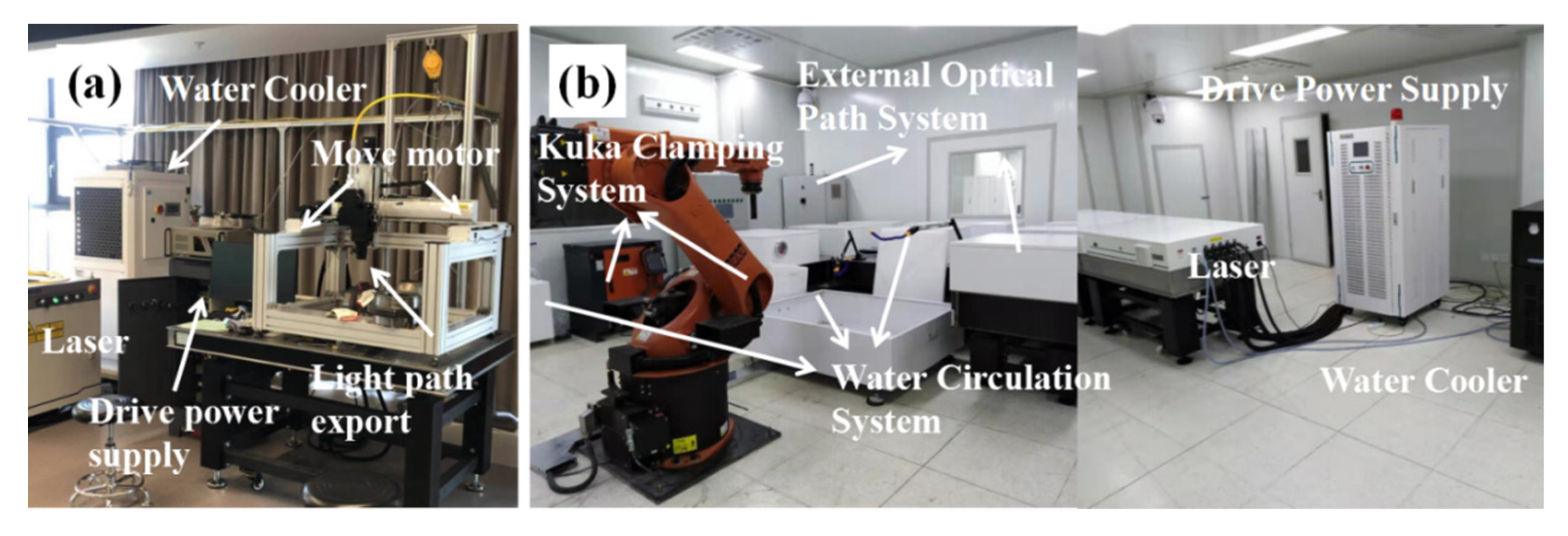
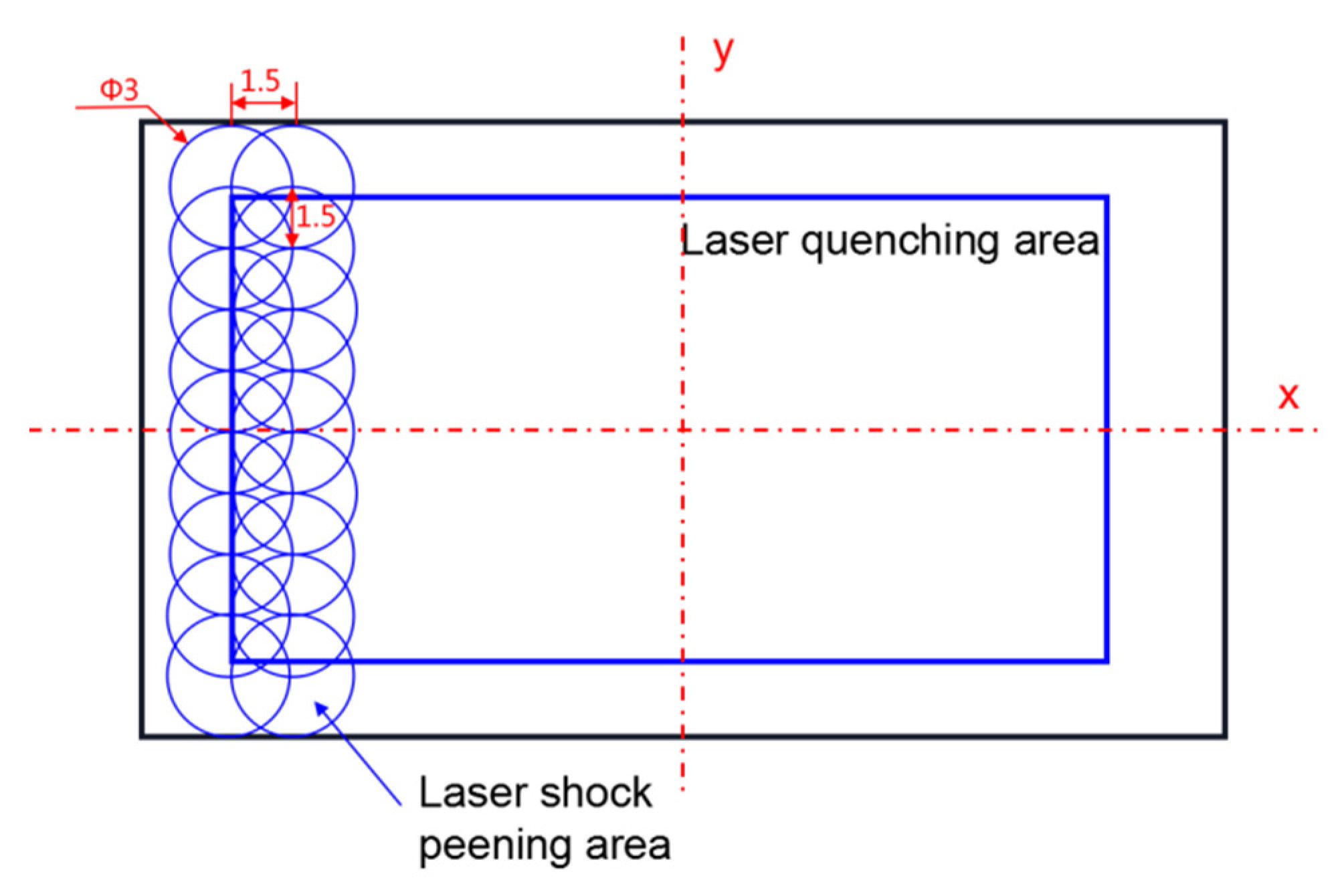

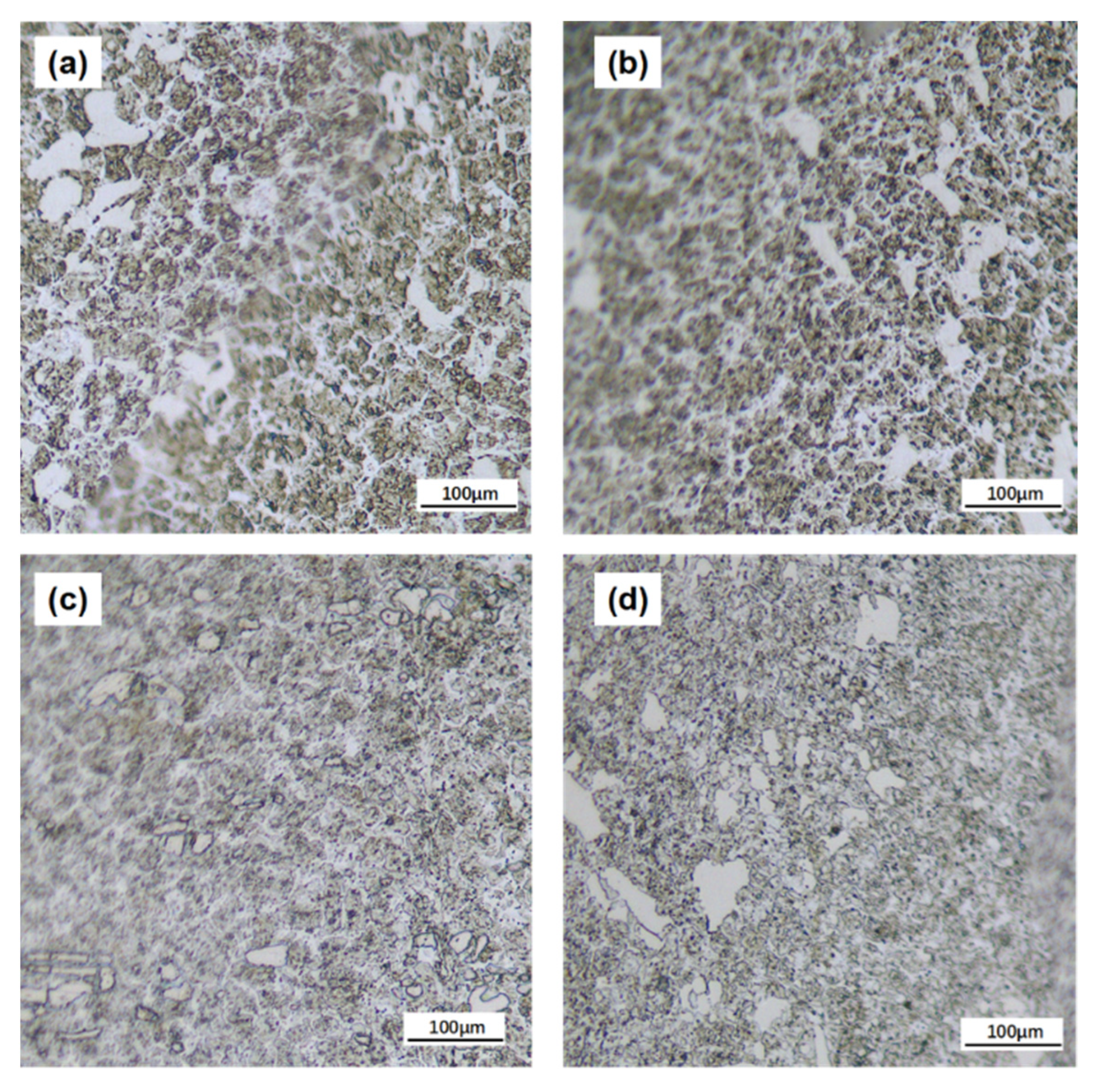
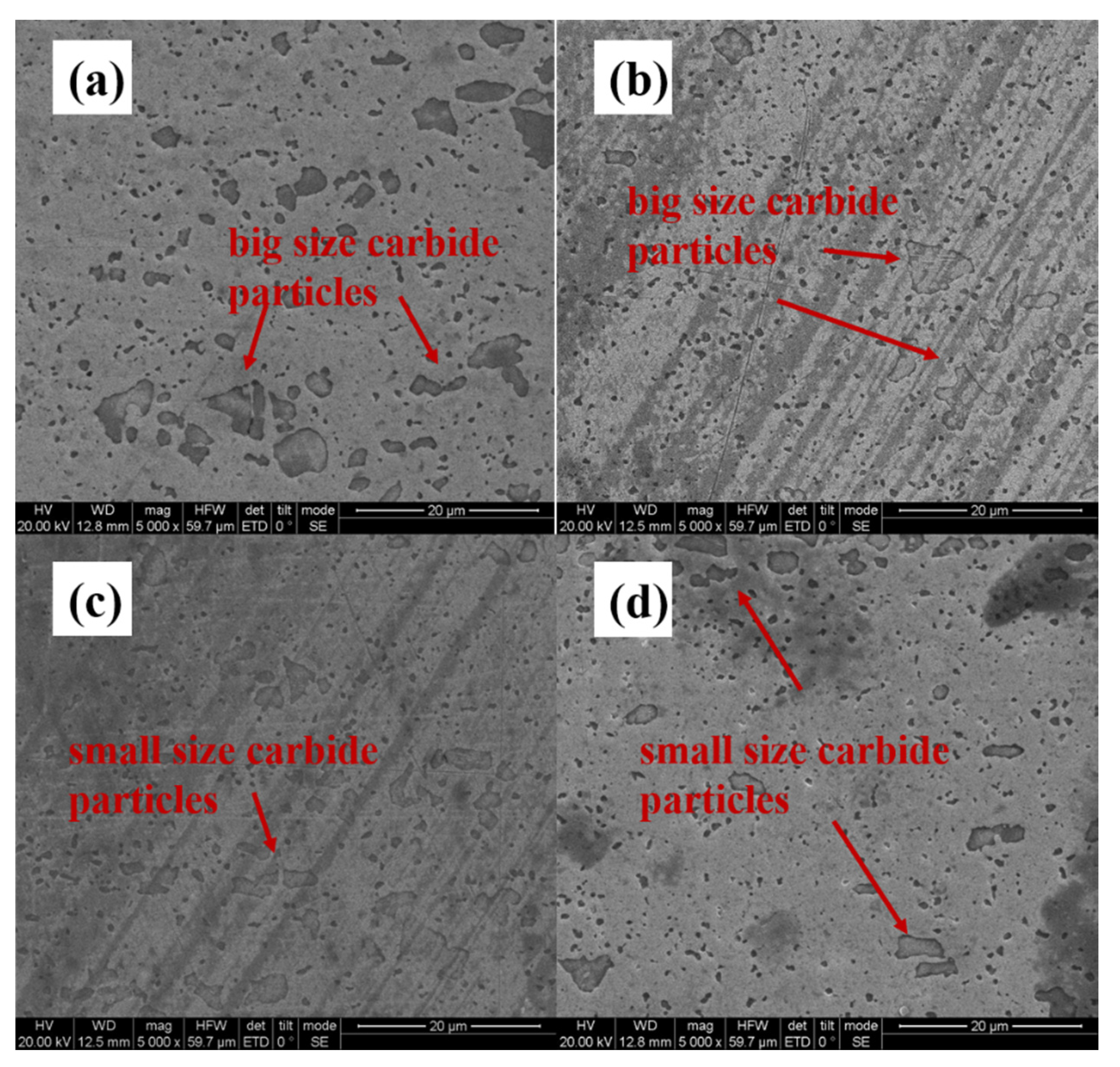
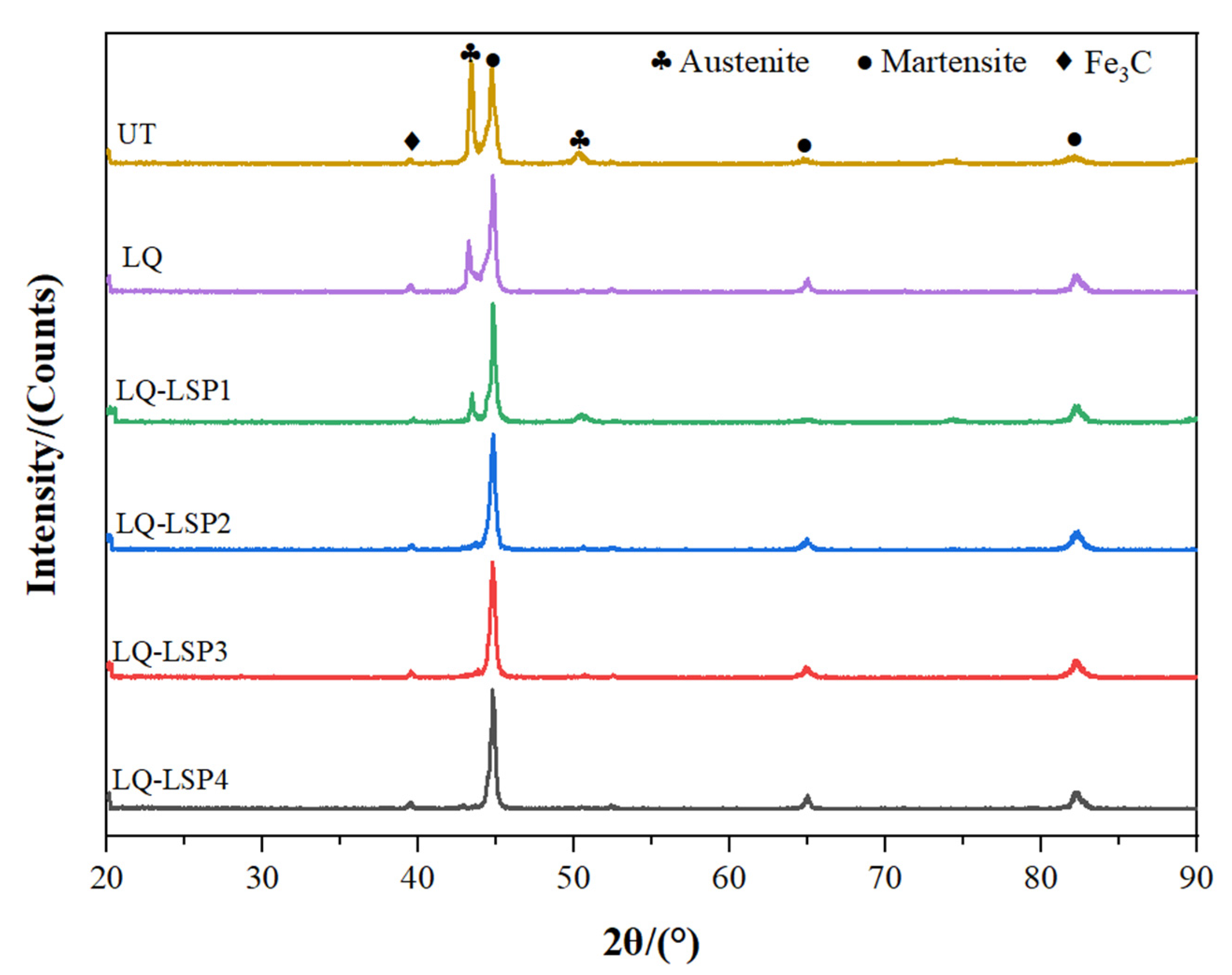
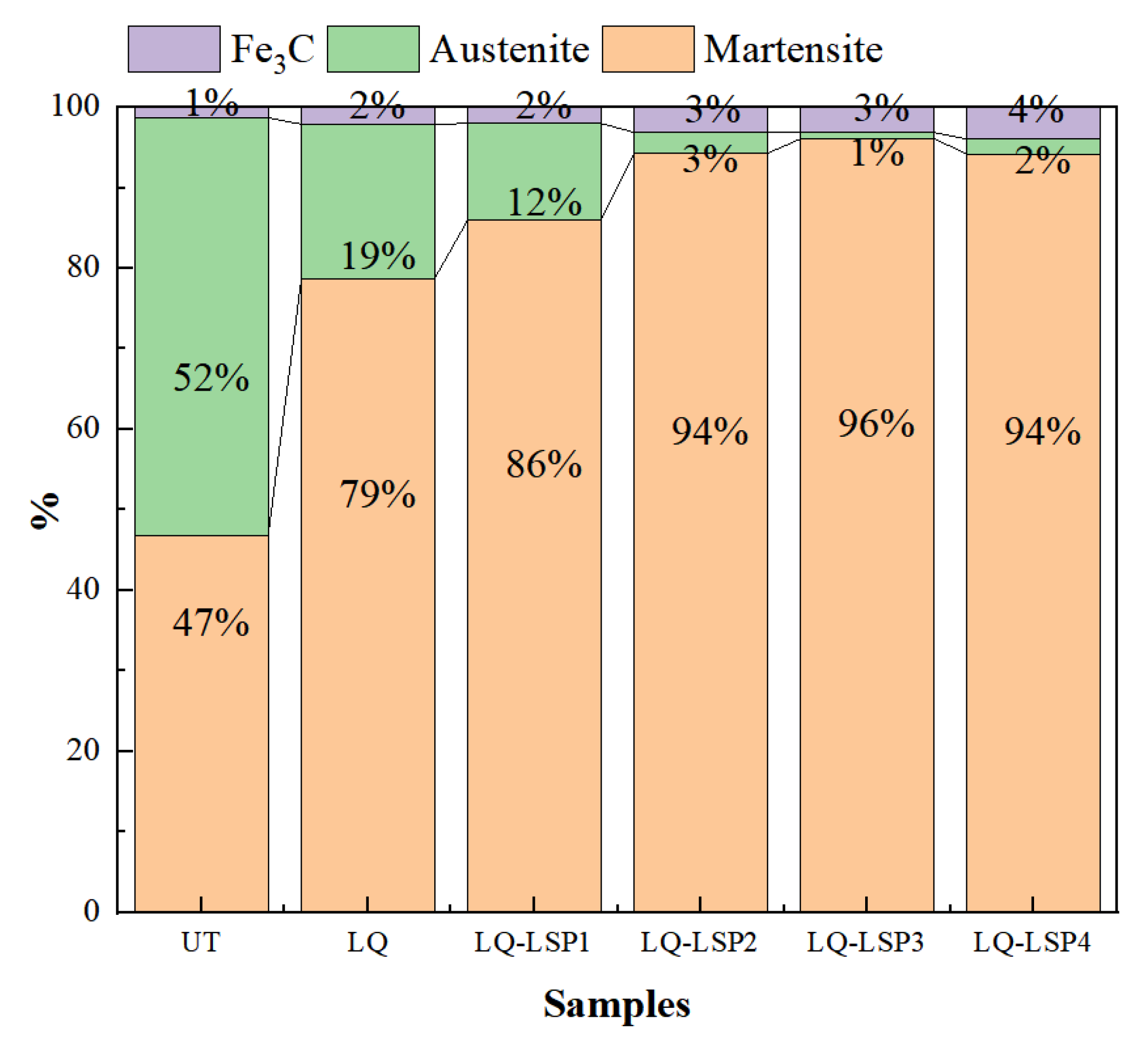

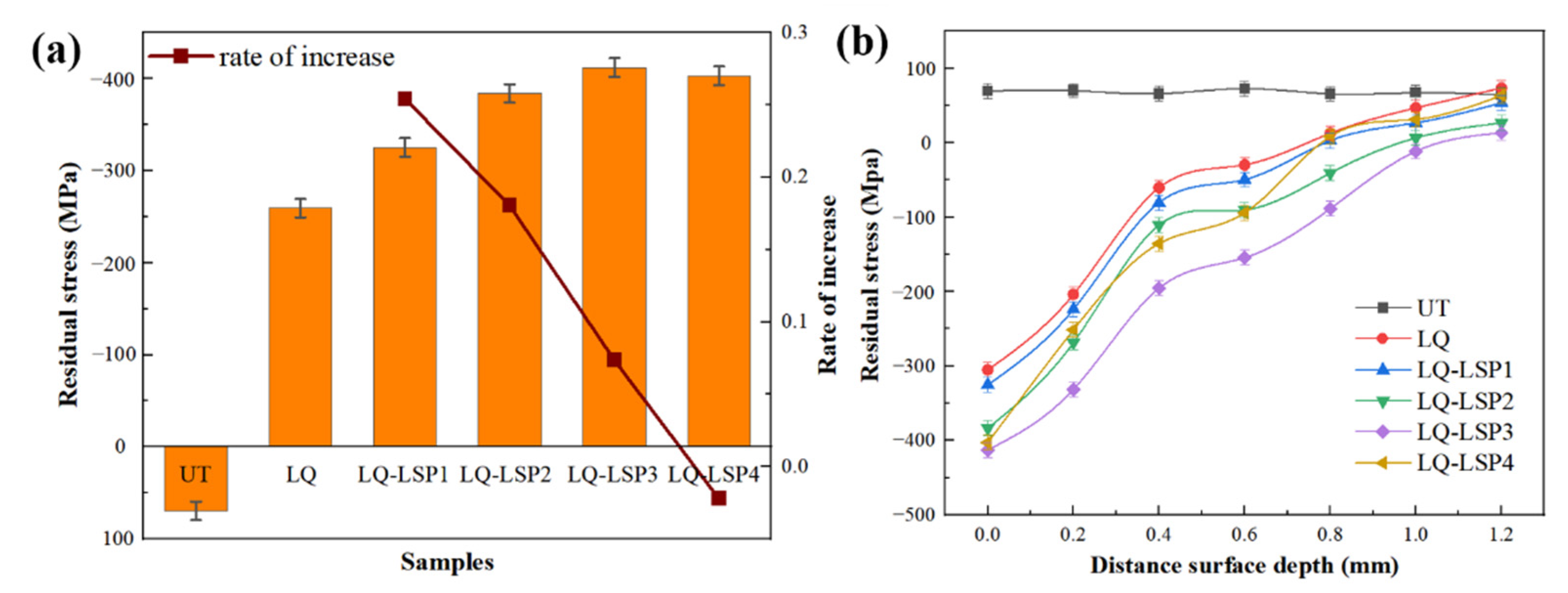
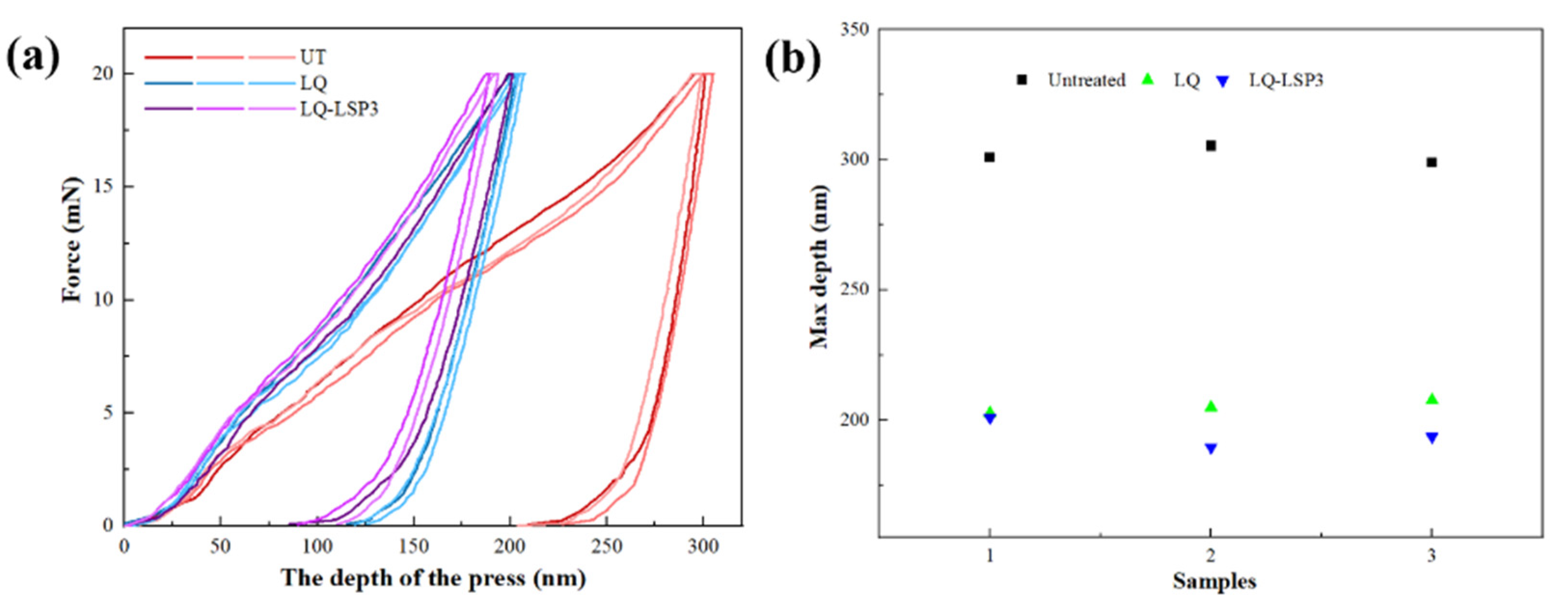
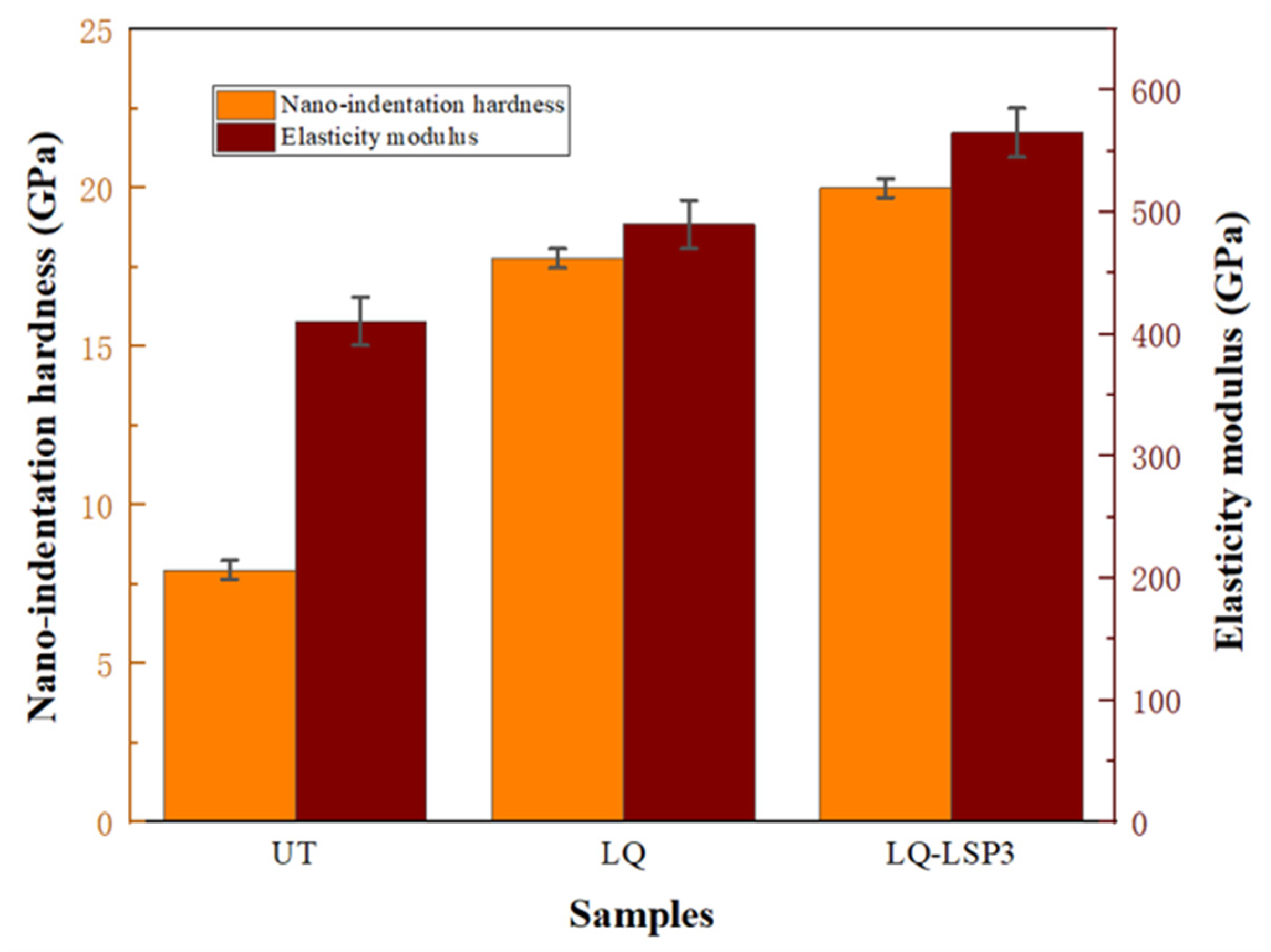
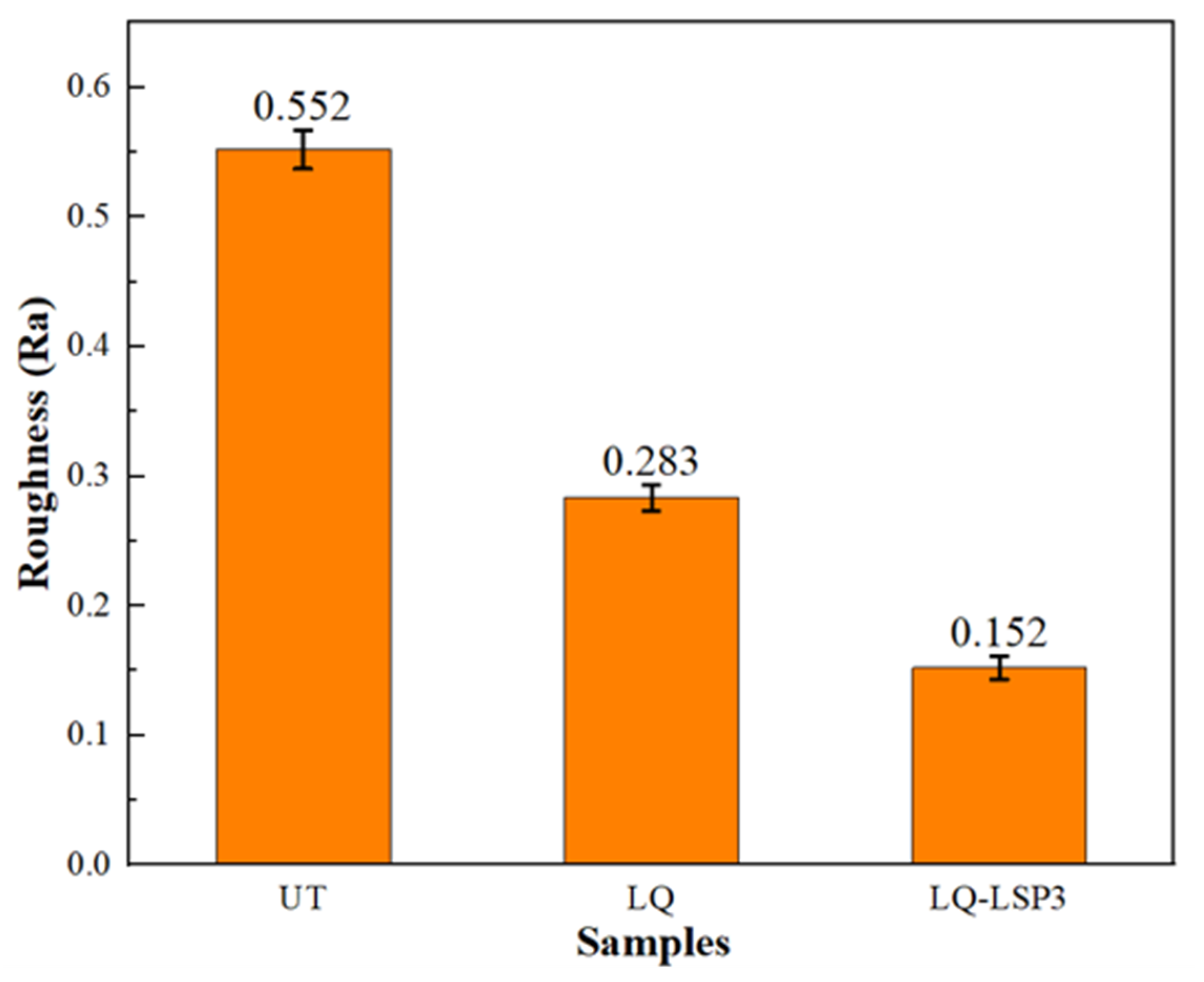

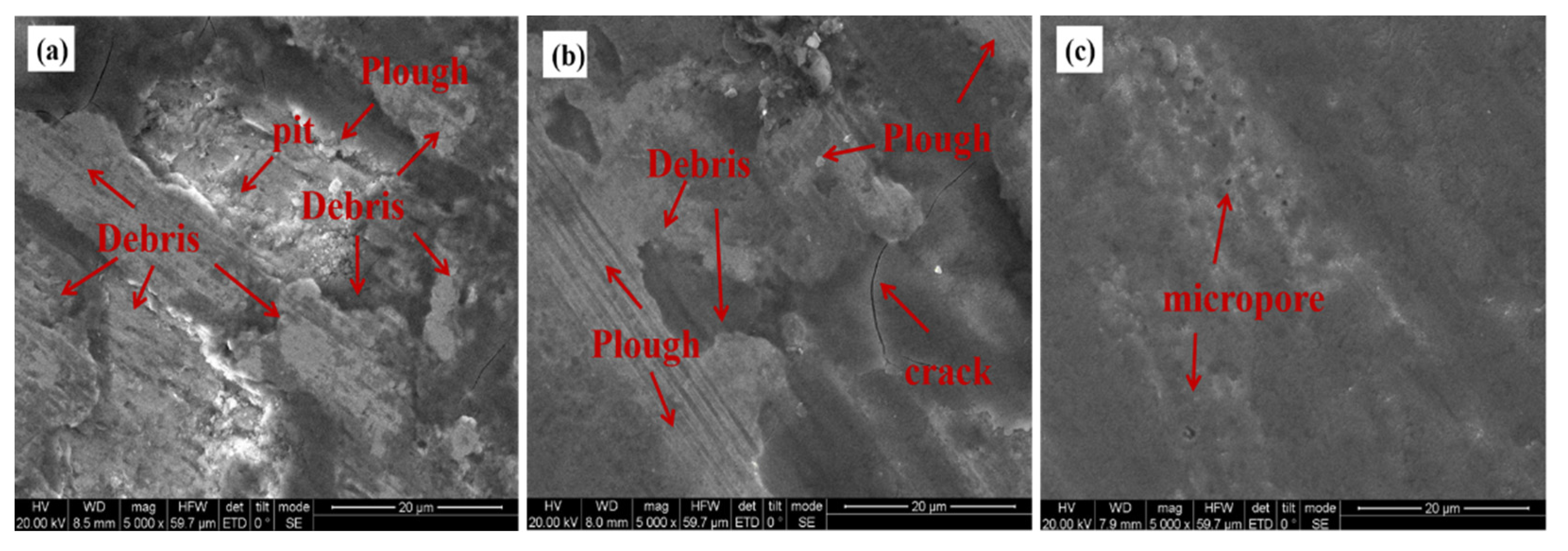
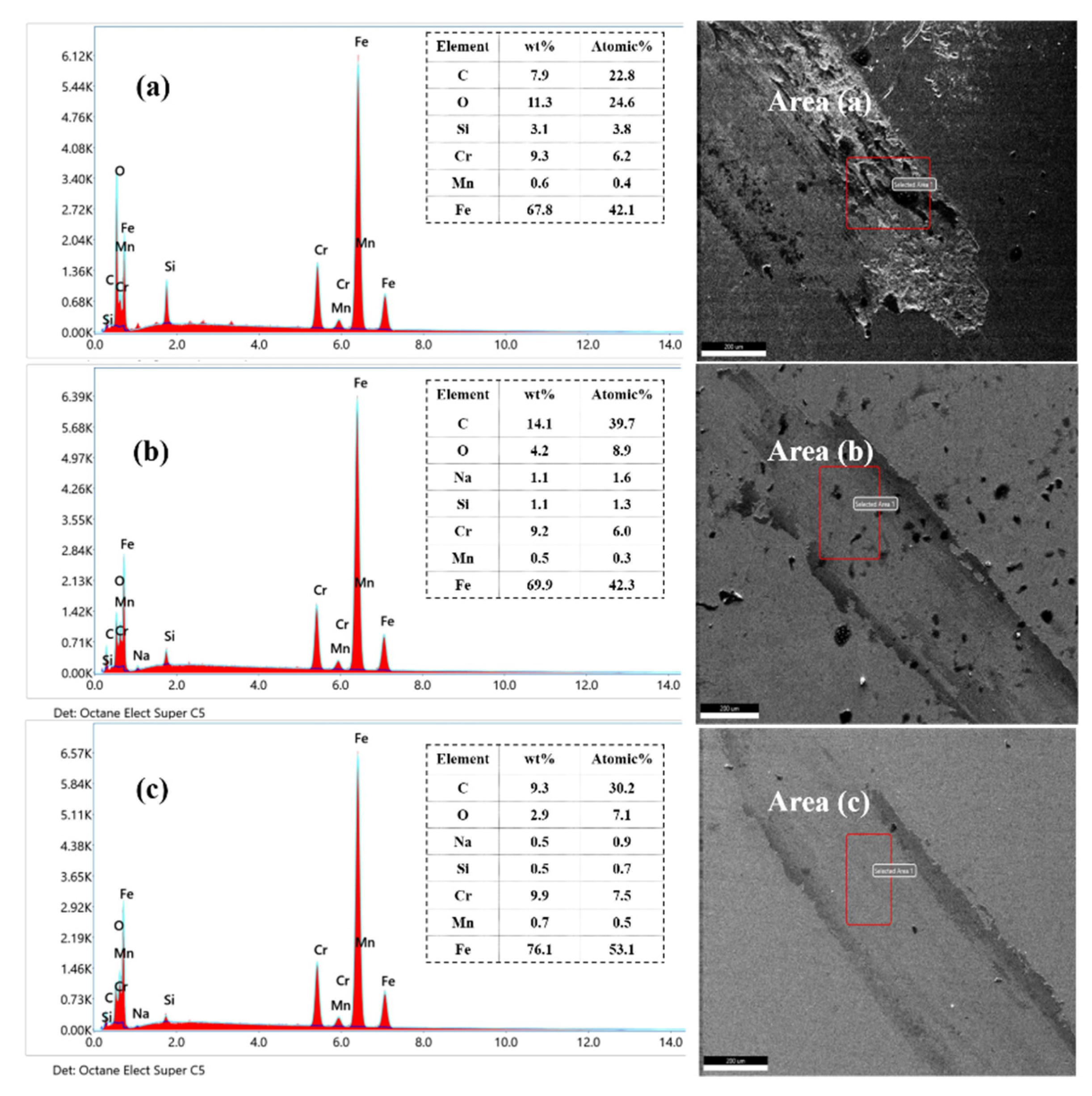
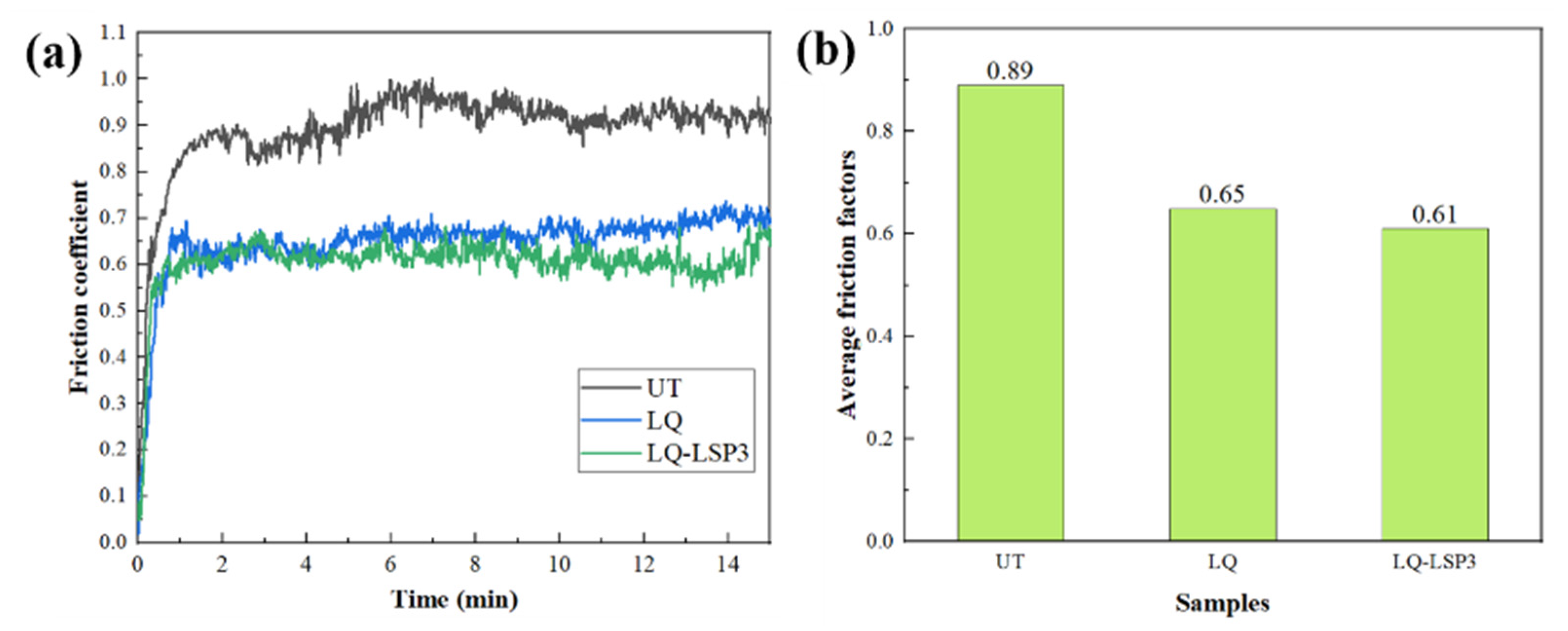

| C | Si | Mn | S | P | Cr | Ni | Cu | V | Mo | Fe |
|---|---|---|---|---|---|---|---|---|---|---|
| 1.45–1.70 | ≤0.40 | ≤0.40 | ≤0.03 | ≤0.03 | 11–12.50 | ≤0.25 | ≤0.30 | 0.9–1.40 | 0.15–0.50 | Bal. |
| Samples | Treatment |
|---|---|
| UT | Untreated |
| LQ | Laser Quenching (1200 W, 4 mm/s) |
| LQ-LSP1 | Laser Quenching (1200 W, 4 mm/s) after Once Laser Shock Peening (10 J) |
| LQ-LSP2 | Laser Quenching (1200 W, 4 mm/s) after twice Laser Shock Peening (10 J) |
| LQ-LSP3 | Laser Quenching (1200 W, 4 mm/s) after Thrice Laser Shock Peening (10 J) |
| LQ-LSP4 | Laser Quenching (1200 W, 4 mm/s) after Quartic Laser Shock Peening (10 J) |
Publisher’s Note: MDPI stays neutral with regard to jurisdictional claims in published maps and institutional affiliations. |
© 2022 by the authors. Licensee MDPI, Basel, Switzerland. This article is an open access article distributed under the terms and conditions of the Creative Commons Attribution (CC BY) license (https://creativecommons.org/licenses/by/4.0/).
Share and Cite
Feng, A.; Zhao, J.; Lin, J.; Pan, X.; Feng, H.; Wang, C.; Lu, Z. Effect of Laser Quenching-Shock Peening Strengthening on the Microstructure and Mechanical Properties of Cr12MoV Steel. Materials 2022, 15, 6693. https://doi.org/10.3390/ma15196693
Feng A, Zhao J, Lin J, Pan X, Feng H, Wang C, Lu Z. Effect of Laser Quenching-Shock Peening Strengthening on the Microstructure and Mechanical Properties of Cr12MoV Steel. Materials. 2022; 15(19):6693. https://doi.org/10.3390/ma15196693
Chicago/Turabian StyleFeng, Aixin, Jian Zhao, Jinhao Lin, Xiaoming Pan, Huibin Feng, Changyu Wang, and Zhengyuan Lu. 2022. "Effect of Laser Quenching-Shock Peening Strengthening on the Microstructure and Mechanical Properties of Cr12MoV Steel" Materials 15, no. 19: 6693. https://doi.org/10.3390/ma15196693
APA StyleFeng, A., Zhao, J., Lin, J., Pan, X., Feng, H., Wang, C., & Lu, Z. (2022). Effect of Laser Quenching-Shock Peening Strengthening on the Microstructure and Mechanical Properties of Cr12MoV Steel. Materials, 15(19), 6693. https://doi.org/10.3390/ma15196693






